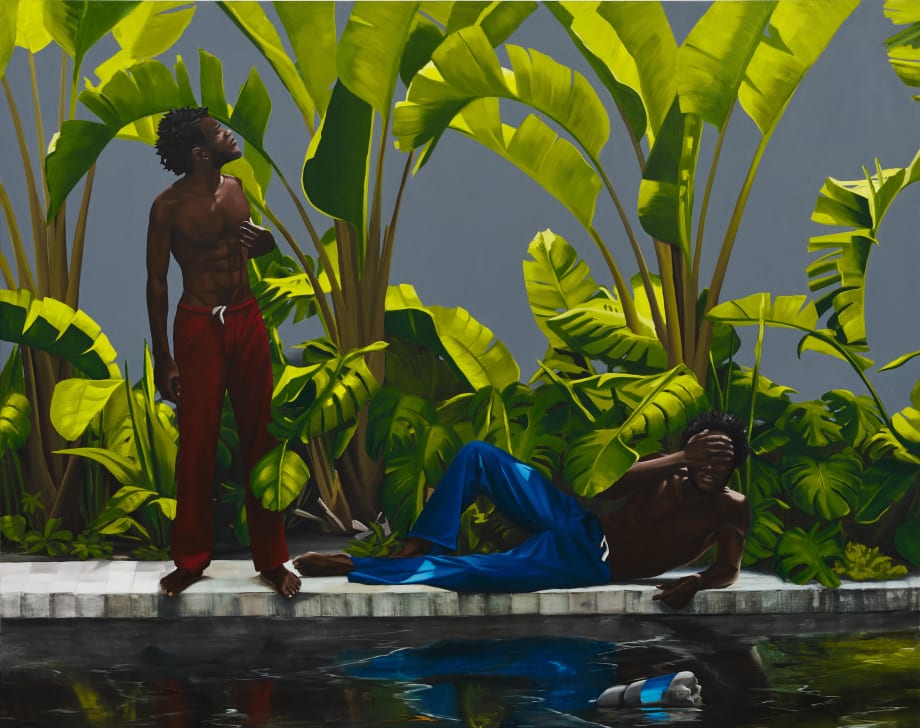Mariane Ibrahim is delighted to present a solo exhibition in Paris of new works by Peter Uka entitled The Triumph of Being. The show will be on view from October 13th to December 2nd, 2023.
There’s a sense of discomfort when you walk into a room and interrupt the flow of conversation. Your brain works double time to piece together the first snippets you overheard and your imagination does its best to fill in the gaps in content and tone. The woman at the center of The Family Forum splits the canvas with her presence, physically manifesting the break in conversation as she searches for a place to fit in.
While Peter Uka’s earlier work was more staunchly rooted in the memories of Benue, Nigeria in the 1970s, as recent losses are layered over increasingly-distant recollections, the new paintings reflect the tension of an interrupted conversation. These scenes are not faithful recreations of people and spaces and fashions in a photorealistic style. They are amalgamations that include, yes, archival photos… but also anachronistic radios, floor patterns sourced from Pinterest, contemporary reprints of hollandais wrapper (Dutch wax) textiles, and entirely imagined characters. Where some faces are taken from his intimate circle, most of them are entirely fabricated. Like proto-AI-generated images sourced from millions of archetypes, or Chinese landscape paintings that synthesize ideal elements to create a totally fictitious scene, Uka’s characters fall between the familiar and the uncanny.
Working across multiple canvases at the same time, and each one reworked through five or six sketches or draft paintings, Uka searches for an emotional connection. He likens the act of painting to therapeutic sessions where he layers then and now, shaping them with elements lost, held, or imagined. The works radiate with subconscious communication—the expressive poses, the coded gestures, the knowing gazes. Elbow Room is based on a specific studio photograph from the Uka family album, an artifact of a moment where the sitter conveys a strong sense of self for the camera. However, the man in yellow is entirely fictionalized from Uka’s imagination while the figure at right is original to the photograph. These paintings are not reenactments or recreations. Figures, faces, and props are repurposed from earlier paintings, echoing the way our memories flatten across time. The artist invites us to doubt our perceptions, to question the nostalgia of memory, to interrupt our conversation.
Across these new paintings, women take center stage. Perhaps some of the credit can be given to Uka’s younger sister, a pathfinder woman who approached the world on her own terms. Her memory is both vibrant and evanescent as Uka, the eldest of five, navigates the realities of losing her in 2022. She’s featured in Yesterday, recalling her defiant behavior of touching the television dials when the Uka children had been explicitly told not to. But in Uka’s scene the little sister of his childhood is replaced by her adult manifestation, a collapsing of then and now, her defiant gaze as a girl embodied in her headstrong disposition as a woman, a light now extinguished.
In building figures from multiple sources of inspiration or fiction, the protagonists become vessels that carry multiple significances at one time. Returning to the aforementioned woman in The Family Forum, the casual viewer might read her as a West African woman from Uka’s past—an aunt or maternal figure. But as he built the figure, fine-tuning her pose and demeanor, he sought external input, from his studio assistant, to the assistant’s North African friend, to a friend from Central Africa now relocated to Cologne… even inviting these women to pose directly in front of the canvas to capture the light across their gestures. His work is no longer singularly rooted in memory, but grafted into his contemporary world. Shells of the past still intermingle with the artist’s research into the material past of his adolescence, but the critical eye must observe that Uka’s new paintings are increasingly brought to life by the neighbors, colleagues, and family who inhabit his network and mental spaces today.
Text written by scholar and curator Joseph L. Underwood, “Between Memory and Myth”, on the occasion of the exhibition.

